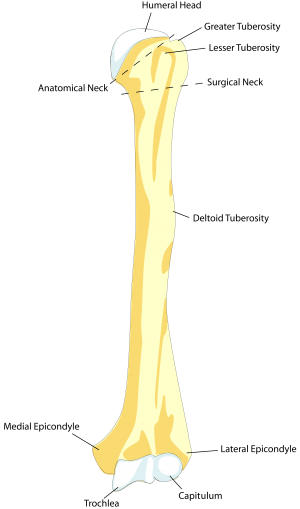Humerus shaft fracture
This page is for adult patients. For pediatric patients, see: humerus shaft fracture (peds)
Background
- Peaks in third and seventh decades of life (young men and osteoporotic elderly women)
- Common site of pathologic fractures (especially breast cancer)
Clinical Features
- Frequently occurs via direct blow or FOOSH
- Localized tenderness, swelling, pain
Differential Diagnosis
Shoulder and Upper Arm Diagnoses
Traumatic/Acute:
- Shoulder Dislocation
- Clavicle fracture
- Humerus fracture
- Scapula fracture
- Acromioclavicular injury
- Glenohumeral instability
- Rotator cuff tear
- Biceps tendon rupture
- Triceps tendon rupture
- Septic joint
Nontraumatic/Chronic:
- Rotator cuff tear
- Impingement syndrome
- Calcific tendinitis
- Adhesive capsulitis
- Biceps tendinitis
- Subacromial bursitis
Refered pain & non-orthopedic causes:
- Referred pain from
- Neck
- Diaphragm (e.g. gallbladder disease)
- Brachial plexus injury
- Axillary artery thrombosis
- Thoracic outlet syndrome
- Subclavian steal syndrome
- Pancoast tumor
- Myocardial infarction
- Pneumonia
- Pulmonary embolism
Evaluation
Workup
- Obtain views of humerus, elbow and shoulder
=Diagnosis
- Rule-out radial nerve injury (wrist drop - no extension of wrist, fingers, or thumb)
Management
General Fracture Management
- Acute pain management
- Open fractures require immediate IV antibiotics and urgent surgical washout
- Neurovascular compromise from fracture requires emergent reduction and/or orthopedic intervention
- Consider risk for compartment syndrome
Specific Management
- Option 1: Long Arm Posterior Splint
- Option 2:
- Stable: coaptation splint (upper arm sugar-tong splint)
- Unstable: elephant ear
Disposition
- Outpatient ortho referral (if adequate pain control)
Subspecialty Orthopedic Care
Non Operative
- Most do not need surgery if
- Less than 20% anterior angulation
- 30% varus/valgus angulation
- < 3cm shortening
Operative
- Neurovascular injury
- Significant soft tissue injury
- Open fracture
- Concern for compartment syndrome
- Floating elbow (ipsilateral forearm fracture)
- Neurovascular injury (radial nerve injury not contraindication to splinting)
See Also
References
This article is issued from
Wikem.
The text is licensed under Creative
Commons - Attribution - Sharealike.
Additional terms may apply for the media files.
